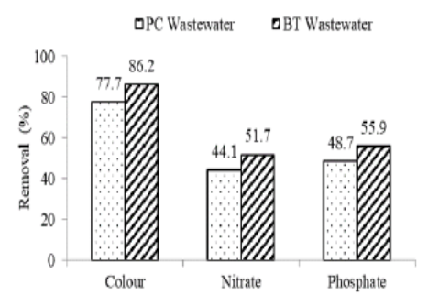


Indian Journal of Science and Technology
Year: 2024, Volume: 17, Issue: 14, Pages: 1409-1418
Original Article
Sushila1, Parveen Kumar2*
1Research Scholar, Department of Basic and Applied Sciences, School of Engineering and Sciences, G D Goenka University, Sohna - Gurugram Road, Sohna, 122103, Haryana, India
2Assistant Professor, Amity School of Earth and Environmental Sciences, Amity University Haryana, Amity Education Valley, Gurugram (Manesar), 122413, Haryana, India
*Corresponding Author
Email: [email protected]
Received Date:22 January 2024, Accepted Date:12 March 2024, Published Date:30 March 2024
Objectives: The present study is aimed to investigate electrocoagulation of domestic wastewater and assessment of pollutants removal efficiency for potential reuse in agriculture. Methods: The electrocoagulation treatment of domestic wastewater with Fe – Fe electrodes was performed under optimal conditions of pH (8.0), current density (0.6 mA/cm2), treatment time (45 minutes), and NaCl dose (2.8 g/L) in a slurry type of reactor. The primary clarified and biotreated domestic wastewaters were subjected to electrocoagulation with Direct Current (DC) as power source. Findings: There was observed higher pollutants removal efficiency from the biotreated wastewater as compared with the primary clarified wastewater after electrocoagulation. The treated wastewaters showed significant removal of pollutants in terms of BOD (79.5% – 87.9%), COD (86.8% – 89.5%), TDS (87.4% – 89.9%), TSS (66.7% – 75.3%), conductivity (77.8% – 78.4%), turbidity (74% – 81.2%), colour (77.7% – 86.2%), nitrates (44.1% – 51.7%), and phosphates (48.7% – 55.9%) after electrocoagulation treatment. Electrocoagulation considerably improved the biodegradability index of the primary clarified (0.59 to 0.92) and biotreated (0.69 to 0.8) wastewaters. This indicates easy removal of the pollutants further by biological processes in the aquatic ecosystems. Electrocoagulation demonstrated potential for removal of pollution from the domestic wastewater for productive reuse in agriculture and urban areas. Novelty: There exist few studies of use of electrochemical process for treatment and reuse of domestic wastewater. The treated waters complied with the regulatory standards and had satisfactory quality for reuse in agriculture and urban activities.
Keywords: Electrocoagulation, Domestic wastewater, Biodegradability index, Agricultural reuse, National Green Tribunal
© 2024 Sushila & Kumar. This is an open-access article distributed under the terms of the Creative Commons Attribution License, which permits unrestricted use, distribution, and reproduction in any medium, provided the original author and source are credited. Published By Indian Society for Education and Environment (iSee)
Subscribe now for latest articles and news.